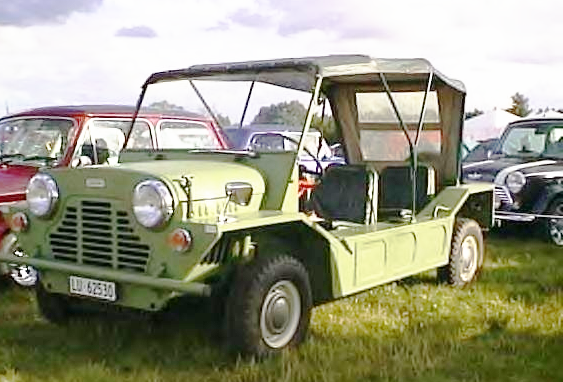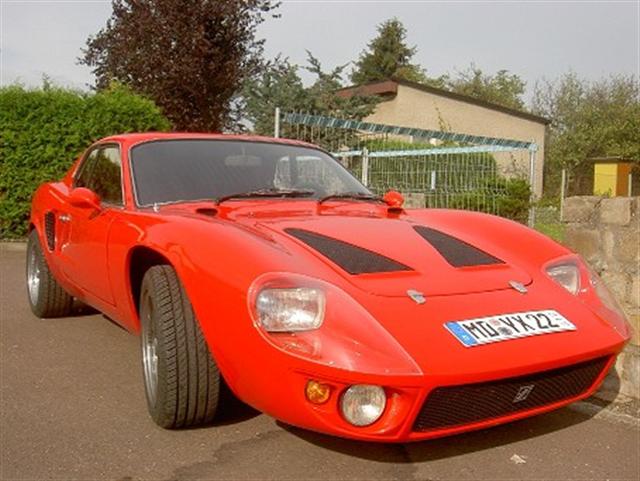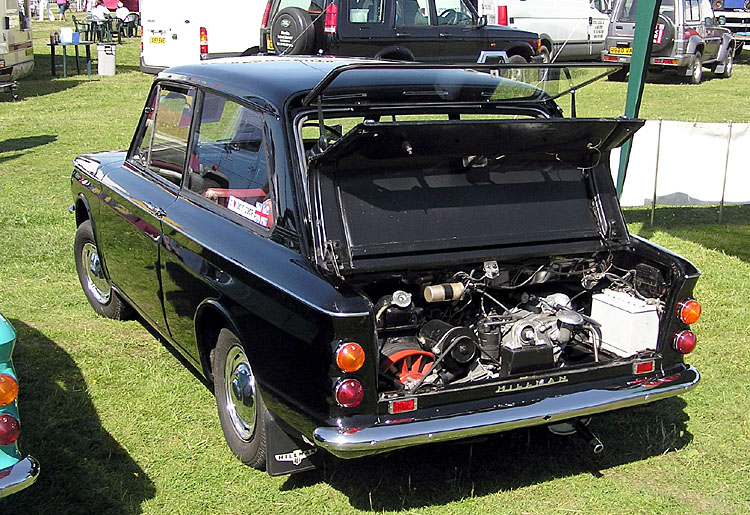|
BS Nymph
The BS Nymph was a fibreglass monocoque British buggy based on running gear from the Hillman Imp, including its rear-mounted 875 cc engine. While meant by Chrysler UK to enter series production to the tune of 4000 cars per annum, the Chrysler corporation discontinued the Imp before the Nymph was released. Rather than competing globally with the Mini Moke as intended, the Nymph entered small-scale production as a kit car and only 42 cars were finished. The designers, Peter Bohanna and Robin Stables, are perhaps best known for having designed the "Diablo GT", which later was developed into the AC 3000ME. Design The Nymph used almost all of the Imp parts aside from the body, with most of the hardware bolted directly to its GRP monocoque. This body was moulded in colour and also fire-retardant. At the time of introduction, a construction time of 50-60 hours were claimed. Doors and a hardtop, as well as a "Surrey"-style softtop, were available as options. By 1977, production had ... [...More Info...] [...Related Items...] OR: [Wikipedia] [Google] [Baidu] |
RR Layout
In automotive design, an RR, or rear-engine, rear-wheel-drive layout places both the engine and drive wheels at the rear of the vehicle. In contrast to the RMR layout, the center of mass of the engine is between the rear axle and the rear bumper. Although very common in transit buses and coaches due to the elimination of the drive shaft with low-floor buses, this layout has become increasingly rare in passenger cars. Overview Most of the traits of the RR configuration are shared with the mid-engine rear-wheel-drive, or MR. Placing the engine near the driven rear wheels allows for a physically smaller, lighter, less complex, and more efficient drivetrain, since there is no need for a driveshaft, and the differential can be integrated with the transmission, commonly referred to as a transaxle. The front-engine front-wheel-drive layout also has this advantage. Since the engine is typically the heaviest component of the car, putting it near the rear axle usually results in mor ... [...More Info...] [...Related Items...] OR: [Wikipedia] [Google] [Baidu] |
Monocoque
Monocoque ( ), also called structural skin, is a structural system in which loads are supported by an object's external skin, in a manner similar to an egg shell. The word ''monocoque'' is a French term for "single shell". First used for boats, a true monocoque carries both tensile and compressive forces within the skin and can be recognised by the absence of a load-carrying internal frame. Few metal aircraft other than those with milled skins can strictly be regarded as pure monocoques, as they use a metal shell or sheeting reinforced with frames riveted to the skin, but most wooden aircraft are described as monocoques, even though they also incorporate frames. By contrast, a semi-monocoque is a hybrid combining a tensile stressed skin and a compressive structure made up of longerons and ribs or frames. Other semi-monocoques, not to be confused with true monocoques, include vehicle unibodies, which tend to be composites, and inflatable shells or balloon tanks, both of which ... [...More Info...] [...Related Items...] OR: [Wikipedia] [Google] [Baidu] |
Kit Car Manufacturers
Kit may refer to: Places *Kitt, Indiana, US, formerly Kit * Kit, Iran, a village in Mazandaran Province * Kit Hill, Cornwall, England People * Kit (given name), a list of people and fictional characters * Kit (surname) Animals * Young animals: ** A short form of kitten, a young cat ** A young beaver ** A young ferret ** A young fox ** A young mink ** A young rabbit ** A young raccoon ** A young skunk ** A young squirrel ** A young wolverine * Old collective noun for a group of pigeons flying together Kinds of sets * Standard equipment and attire in sports: ** Kit (association football) ** Kit (cycling) ** Kit (rugby football) * Kit (of components), a set of components such as ** Electronic kit ** Kit car or component car **Testing kit (other) Other uses * Kit lens, a low-end SLR camera lens * Kit violin or kit, a small stringed musical instrument * Tropical Storm Kit, tropical cyclones named Kit * ''Whale (film)'', 1970, Bulgarian title See also * * * ... [...More Info...] [...Related Items...] OR: [Wikipedia] [Google] [Baidu] |
Defunct Motor Vehicle Manufacturers Of England
{{Disambiguation ...
Defunct (no longer in use or active) may refer to: * ''Defunct'' (video game), 2014 * Zombie process or defunct process, in Unix-like operating systems See also * * :Former entities * End-of-life product * Obsolescence Obsolescence is the state of being which occurs when an object, service, or practice is no longer maintained or required even though it may still be in good working order. It usually happens when something that is more efficient or less risky r ... [...More Info...] [...Related Items...] OR: [Wikipedia] [Google] [Baidu] |
Glassfibre
Fiberglass (American English) or fibreglass (Commonwealth English) is a common type of fiber-reinforced plastic using glass fiber. The fibers may be randomly arranged, flattened into a sheet called a chopped strand mat, or woven into glass cloth. The plastic matrix may be a thermoset polymer matrix—most often based on thermosetting polymers such as epoxy, polyester resin, or vinyl ester resin—or a thermoplastic. Cheaper and more flexible than carbon fiber, it is stronger than many metals by weight, non-magnetic, non-conductive, transparent to electromagnetic radiation, can be molded into complex shapes, and is chemically inert under many circumstances. Applications include aircraft, boats, automobiles, bath tubs and enclosures, swimming pools, hot tubs, septic tanks, water tanks, roofing, pipes, cladding, orthopedic casts, surfboards, and external door skins. Other common names for fiberglass are glass-reinforced plastic (GRP), glass-fiber reinforced plastic (GFRP) or GFK ( ... [...More Info...] [...Related Items...] OR: [Wikipedia] [Google] [Baidu] |
AC 3000ME
The AC 3000ME is a mid-engined sports car originally sold by AC Cars. The two-door coupé debuted at the 1973 London Motor Show. Sales did not begin until 1979 and lasted until 1984. Rights to the 3000ME and tooling were transferred to a second company who managed to produce a small number of additional cars before going into receivership themselves in mid-1985. A third company acquired the rights to the car with plans to begin selling a revised version under a different name, but only a single prototype was ever produced. History Origin The AC 3000ME was based on a prototype called the Diablo built by the ''Bohanna Stables'' company and shown at the London Racing Car Show in 1972. Peter Bohanna was an automotive body structures engineer. His experience included working with fibreglass structures as a boat engineer and a stint with Ford's Advanced Vehicle Operations in the UK doing bodywork for the Ford GT40. In late 1967 Bohanna was at Lola cars working on the T70, where he me ... [...More Info...] [...Related Items...] OR: [Wikipedia] [Google] [Baidu] |
Mini Moke
The Mini Moke (styled "MOKE") is a small, front-wheel-drive utility and recreational convertible, conceived and manufactured as a lightweight military vehicle by British Motor Corporation (BMC), and subsequently marketed for civilian use under the Austin, Morris, Leyland, and Moke brands. The name "Mini Moke" combines ''Mini'' with ''Moke'', an archaic term for "mule". The Moke is known for its simple, straightforward, doorless design, and for its adaptability. The first Mokes were manufactured at BMC's Longbridge, Birmingham plant, with 14,518 produced in the UK between 1964 and 1968. 26,000 were manufactured in Australia between 1966 and 1981, and 10,000 in Portugal between 1980 and 1993 when, after a nearly 30-year run, production ended. In 2013, in a joint venture with Jaguar Land Rover, Chinese automaker Chery Automobile started production of a new car called Moke in China. MOKE America distributes the Moke in the United States. British production by MOKE Internation ... [...More Info...] [...Related Items...] OR: [Wikipedia] [Google] [Baidu] |
Running Gear
In railway terminology the term running gear refers to those components of a railway vehicle that run passively on the rails, unlike those of the driving gear. Traditionally these are the wheels, axles, axle boxes, springs and vehicle frame of a railway locomotive or wagon. The running gear of a modern railway vehicle comprises, in most instances, a bogie frame with two wheelsets. However there are also wagons with single axles (fixed or movable) and even individual wheels. Since in modern times, locomotives no longer require separate driving and carrying axles (see wheel arrangement), as was formerly common with steam locomotives, but usually have bogies where all axles are driven, the term running gear is (inaccurately) superseding the term 'driving gear' in some parts of the world. References See also * Bogie A bogie ( ) (in some senses called a truck in North American English) is a chassis or framework that carries a wheelset, attached to a vehicle—a modular s ... [...More Info...] [...Related Items...] OR: [Wikipedia] [Google] [Baidu] |
Fibreglass
Fiberglass (American English) or fibreglass (Commonwealth English) is a common type of fiber-reinforced plastic using glass fiber. The fibers may be randomly arranged, flattened into a sheet called a chopped strand mat, or woven into glass cloth. The plastic matrix may be a thermoset polymer matrix—most often based on thermosetting polymers such as epoxy, polyester resin, or vinyl ester resin—or a thermoplastic. Cheaper and more flexible than carbon fiber, it is stronger than many metals by weight, non-magnetic, non-conductive, transparent to electromagnetic radiation, can be molded into complex shapes, and is chemically inert under many circumstances. Applications include aircraft, boats, automobiles, bath tubs and enclosures, swimming pools, hot tubs, septic tanks, water tanks, roofing, pipes, cladding, orthopedic casts, surfboards, and external door skins. Other common names for fiberglass are glass-reinforced plastic (GRP), glass-fiber reinforced plastic (GFRP) or ... [...More Info...] [...Related Items...] OR: [Wikipedia] [Google] [Baidu] |
Buggy (automobile)
Buggy is generally used to refer to any lightweight automobile with off road capabilities and sparse bodywork. Most are built either as a kit car or from scratch. History Originally used to describe very lightweight horse-drawn vehicles for one or two persons, the term was extended to lightweight automobiles as they became popular. As automobiles became increasingly sophisticated, the term briefly dropped out of use before being revived to describe more specialised off road vehicles. Types * Bennett buggy, a Canadian, depression era term for an automobile pulled by a horse * Dune buggy, designed for use on sand dunes * Baja Bug, a modified Volkswagen Beetle * Moon buggy, nickname for the Lunar Roving Vehicle used on the Moon during the Apollo program's Apollo 15, Apollo 16, and Apollo 17 missions * Sandrail, a variant of the dune buggy * Swamp buggy, designed for use in swamps * Rock buggy, designed for use in low-speed rock-crawling applications * Rock bouncer, simi ... [...More Info...] [...Related Items...] OR: [Wikipedia] [Google] [Baidu] |
Kit Car
A kit car is an automobile available as a set of parts that a manufacturer sells and the buyer then assembles into a functioning car. Usually, many of the major mechanical systems such as the engine and transmission are sourced from donor vehicles or purchased new from other vendors. Kits vary in completeness, consisting of as little as a book of plans, or as much as a complete set with all components to assemble into a fully operational vehicle such as those from Caterham. Related terms There is also a sub-set of the kit car, commonly referred to as a "re-body", in which a commercially manufactured vehicle has a new (often fiberglass) body put on the running chassis. Most times, the existing drive gear and interior are retained. These kits require less technical knowledge from the builder, and because the chassis and mechanical systems were designed, built, and tested by a major automotive manufacturer, a re-body can lead to a much higher degree of safety and reliability. ... [...More Info...] [...Related Items...] OR: [Wikipedia] [Google] [Baidu] |
Hillman Imp
The Hillman Imp is a small economy car that was made by the Rootes Group and its successor Chrysler Europe from 1963 until 1976. Revealed on 3 May 1963, after much advance publicity, it was the first British mass-produced car with the engine block and cylinder head cast in aluminium. Being a direct competitor to the BMC's Mini, it used a space-saving rear-engine, rear-wheel-drive layout to allow as much luggage and passenger capacity as possible in both the rear and the front of the car. It used a unique opening rear hatch to allow luggage to be put into the back seat rest. It was the first mass-produced British car with the engine in the back and the first to use a diaphragm spring clutch. The baulk-ring synchromesh unit for the transaxle compensated for the speeds of gear and shaft before engagement, from which the Mini had suffered during its early production years. It incorporated many design features which were uncommon. Among them were a folding rear bench seat, autom ... [...More Info...] [...Related Items...] OR: [Wikipedia] [Google] [Baidu] |








